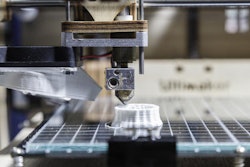Some of you watching might remember a film that debuted in 1986 called Aliens. Now, for those of you who haven’t seen the film or need a reminder, the science fiction blockbuster featured some pretty impressive body armor donned by some fairly intense U.S. Marines. Particularly noteworthy was the articulated arm attached to the body armor to help soldiers tote around their massive smart guns.
Well, according to the Army News Service, the Army Research Laboratory is investigating using a very similar system to lighten the weight of machine gunners.
The Army prototype features the distinctive articulated arm that’s attached the body armor, with the carbon fiber arm able to hold the weapon either during combat or at rest. Currently, the arm can hold up to 20 pounds and can be attached to either side of a soldier’s ballistic vest.
Because the articulated arm would be able to bear the full weight of most weapons (say an M249), this helps reduce soldier fatigue while also allowing the wearer to use a radio or read a map all while having his weapon ready at a moment’s notice.
Eventually, researchers would like to test the articulated arm prototype with heavier and larger weapons.
SO, WHAT DO YOU THINK?
Can you imagine this sci-fi inspired articulated arm on the battlefield or would it be more hindrance than help? Leave your comments in the section below.
Putting Robots In The Friend Zone
It’s a common sight these days to see man and machine working together in manufacturing facilities. However, for safety reasons, these heavy-duty robots — which can easily lift components weighing hundreds of pounds — can pose a risk to human lives. Which is why they operate in separate cells from their human counterparts. Until now.
The Fraunhofer Institute for Machine Tools and Forming Technology has been working to come up with a way robots and people can safely work side-by-side in a manufacturing environment.
The safety concept defines different levels of collaboration —more intensive interaction between person and machine equals more stringent safety regulations. Fraunhofer developed three spatial work zones.
When the person is in the green zone, the robot works at full speed. When the worker enters the yellow “zone of cooperation” the robot will continue to do its work, but more slowly. Once the worker enters the red zone, the machine shuts down.
Researchers say the system is fully functional and has been tested in the lab and they hope to have trade associations test the application and move toward use in the industry.
SO, WHAT DO YOU THINK?
Do you think implementing a zone of cooperation would improve human-robot interactions and efficiency in manufacturing? Tell us what you think in the comments below.
MM: Body Armor Inspired By An 80s Classic
In this episode, putting robots in the friend zone and body armor inspired by an 80s classic.
Apr 7, 2017
Latest in Industry 4.0






















